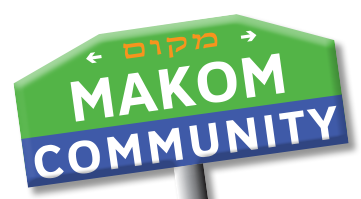Another beautiful week at Makom has come and gone. As we worked through themes of companionship, helping, and the mitzvah (commandment) of the essential Jewish prayer, Shema. I observed so many moments of growth and learning this week.

During snack time learning, we tested out our peace walk. Learners have been creating this resource to support problem-solving with agency when interpersonal conflicts come up. Kiddos generated ideas for each step, discussed which steps were most important, wrote them down, and created visual representations that communicated what each step looked like. I asked everyone to come up with a problem for us to use as we tested out the peace walk.

One learner volunteered a real problem that he has been running into at school “I keep forgetting where my lunch spot is.” We elaborated on this problem with some imagination in order to make it a good sample problem for our peace walk. Another learner added “He keeps forgetting where his lunch spot is, and another friend at school is saying not nice words to him about it.” Together we worked our way to a solution. A thoughtful kiddo shared the idea to “put his name at his lunch spot.” Another kiddo chimed in to say that this is a solution that really happens at his school for the younger kids, and older kids just have to remember.

The learners laid out the peace walk and two volunteers acted out the scenario. Step one is “say truce.” One of our learners explained why he chose to include this step, “when two countries are at war and they want to stop they say truce.” We discussed that just because we say truce and agree to stop arguing does not mean that the problem is solved, but it helps us get on the same page about moving forward.
Peace Walk Steps:
- Say truce.
- Take a deep breath.
- Go to the Pinat Shalom. (peace corner)
- Take turns saying what you need.
- Repeat back what the other person said.
- Make a compromise/problem solve.
- Make a peace sign or bump elbows or say sorry.
When we came to step 3 “take turns saying what you need” we uncovered what was laying beneath the not nice words. One of our actors explained “the kid is saying not nice words because they are frustrated that the other kid is sitting in their seat!” We continued to work through the peace walk and I was filled with pride as I watched learners begin to put their thoughtful efforts to use. Observing the kiddos work together and support each other through this process was a wonderful exploration of “rising each other up” which we investigated this week in the book of Kohelet. Ecclesiastes 4:9-10


During a special Tefilah: Prayer, Music, and Movement we dove into the Shema. We learned how to sign the Shema in ASL. With each sign we discussed the translation of each word. As we signed the word Shema we discussed that the English translation of “hear” is not inclusive of our Deaf and Hard of Hearing neighbors .For this reason, the ASL interpretation is “pay attention.” During this unit which is all about welcoming this felt particularly important to pause and consider. Once we all knew the prayer in Hebrew and ASL, each student chose a word and drew their interpretation of that word’s meaning. Together we meditated on the idea of oneness and the profound connection we all share. One student shared “Yisrael is not just the place, it is also our whole community!” If you would like to learn or practice signing the Shema with your kiddos, Rabbi Darby Jared Leigh has a wonderful video tutorial!

During Shulchanot Avodah (project centers) kiddos sculpted, crafted, wrote, drew, and explored. Many learners this week were particularly invested in creating their own ritual objects. With upcycled materials they taped, cut, and manipulated various objects into sculptures that represented concepts of importance to them.

Some explanations of their creations were:
“It keeps me safe from animals and other things.”
“It’s a kippah holder.”
“It’s a sukkah with feathers to keep me warm and fuzzy.”
“It helps me remember that it’s okay when I don’t have an idea.”
“It reminds me of Makom.”
“It’s my house and my bed, I will use it when I go to sleep.”
“It’s a guitar and a drum.”
I have so much gratitude for witnessing and participating in your children’s process of navigating our learning landscape. It is truly a pleasure. Next week we’ll be delving into communication, relationships, and responsibility.

